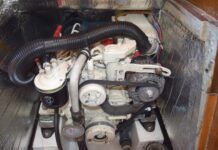On my 40’ wood boat Daybreak I had a stuffing box problem. The gland leaked worse and worse, especially when motoring. It is very inaccessible, and could not be further tightened.
The stuffing box needed to be repacked, but this couldn’t be done without major effort because of insufficient space between the gland and the shaft coupling at the transmission. The Lasdrop shaft seal looked like it might solve several problems at the same time.
Lasdrop was ordered from Lemania Company, 1777 SE 15th Street, Suite 507E, Ft. Lauderdale, FL 33316, (305) 523-1824. This company is the US importer/distributor of this French-made seal.
The first version of the seal I received, which cost about $55, had a bellows which was too small for the stern tube.
-Lasdrop replaces the rubber hose and stuffing box usually used, while the stern tube is still part of the system.
After several phone calls and a month’s delay, I was sent a more expensive unit -about $70 -with a “B” Type bellows. The bellows fit the stern tube on my boat, but the hole in the plastic ring which the bellows compresses against the stainless steel shaft ring was for a shaft size of about 1 5/8”. This made me very nervous, because it seemed to me that if the stainless ring were to slip on the shaft, I would have a leak around the shaft equivalent to about a I” diameter hole.
I sent the plastic ring back and asked for one with a hole just large enough to fit over the 1 1/8″ shaft in the boat. A new ring was sent about a month later, along with an additional charge of about $25. The hole in the new ring was still larger than the shaft, but much less so than the first version. My total cost was now up to about $100, plus phone calls.
Installation wasn’t easy. The instructions tell you to slide the stainless steel ring and its O-ring over the shaft after polishing and oiling the shaft. In my case, forcing the ring onto the shaft was very difficult, even with a brand new shaft, and with the shaft polished, lubricated, and out of the boat for a pretrial. You can’t twist or rotate the stainless steel ring against the shaft to try to help get it in position, or the edge of the keyway for the coupling may destroy the O-ring which seals the stainless ring against the shaft. The O-ring is small, and pretty delicate.
The stainless steel ring is machined to almost the exact size of the shaft -as it must be, for a good seal -and the inside of the ring has sharp edges. I found that in my test fitting the stainless ring left numerous scrape marks on the new bronze shaft. Some of the scrapings seemed to find their way between the ring and the shaft, jamming the O-ring and damaging it. Spare O-rings should be provided in case you damage one, but they are not shipped with the unit.
Installation of the unit with the shaft in the boat was even harder. In the tight space I had to work in it was nearly impossible to get the stainless ring over the shaft. The difficulty in this task will certainly depend on the accessibility to the shaft in your boat, and will not necessarily be as difficult as the situation I faced.
With a couple of hours of work hanging upside down in the bilge in a very tight place, I eventually got the ring on, tapping with a hammer. The bellows portion of Lasdrop seems to me to be of surprisingly light rubber, given the fact that it has a fair amount of area that could be vulnerable to damage. The bellows is the only thing stopping the water in the stern tube from entering the boat, so you want it to be pretty heavy duty.
The bellows is held in place on the stern tube at its after end and on the plastic ring at its forward end with hose clamps, just like the hose on a normal flexible stuffing box. The clamps used on Lasdrop -two on each end -are about half the width of a standard hose clamp. In my experience -which includes thousands of miles of ocean sailing, much of it singlehanded -stainless steel hose clamps have a limited life, frequently breaking due to corrosion. I fear that the narrow hose clamps used on the unit might be a weak point. The manufacturer states that there have been no major failures in the dozen years the unit has been in use, although he recommends replacing the clamps every five or six years.
The narrow clamps are used because there isn’t enough lip on the ends of the bellows to use two full-width hose clamps, and two clamps are recommended on all under water hose connections.
Another problem I had was with the three allen-head set screws used to secure the stainless steel ring to the shaft. These set screws are quite small in diameter, so great care must be exercised when tightening them down to keep from breaking them off. I managed to break one with very little pressure while tightening it down, so now I can’t remove the unit without drilling out the remains of the old set screw. For the sake of comparison, the shaft flange in my boat is held on by the key and keyway, plus two 3/8” diameter set screws which are wired together to keep them from loosening. Despite the tight fit of the ring on the shaft, it would seem to me to be prudent to use a larger set screw, if for no other reason than to keep them from being broken by an over-zealous installer with visions of water pouring into his boat through the stern tube.
In the instructions, it is advised that the stainless steel ring be backed up with a hose clamp around the prop shaft behind the ring, but this probably wouldn’t be necessary if the set screws in the ring were heavier duty. The suggested hose clamp, by the way, isn’t supplied with the unit.
For some installations, Lasdrop may be better than a traditional stuffing box, for example, when access to the box is so difficult that routine repacking of the stuffing box is neglected. The tendency with a difficult-to-reach stuffing box is to merely tighten the box further to reduce or eliminate leaking. Unfortunately, this is likely over time to score the shaft, making the leak worse. Lasdrop does eliminate the necessity of tightening the box, so that there should be no danger of scoring the shaft.
The traditional stuffing box with its flax packing, however, has the advantage of being cheap an entire replacement stuffing box for a 1 1/8″ shaft costs less than $50 -relatively foolproof, uncomplicated, and a long history of reliability. For conservative sailors, that alone may be enough to keep the tried and true stuffing box aboard.
– J. Norwalk


































